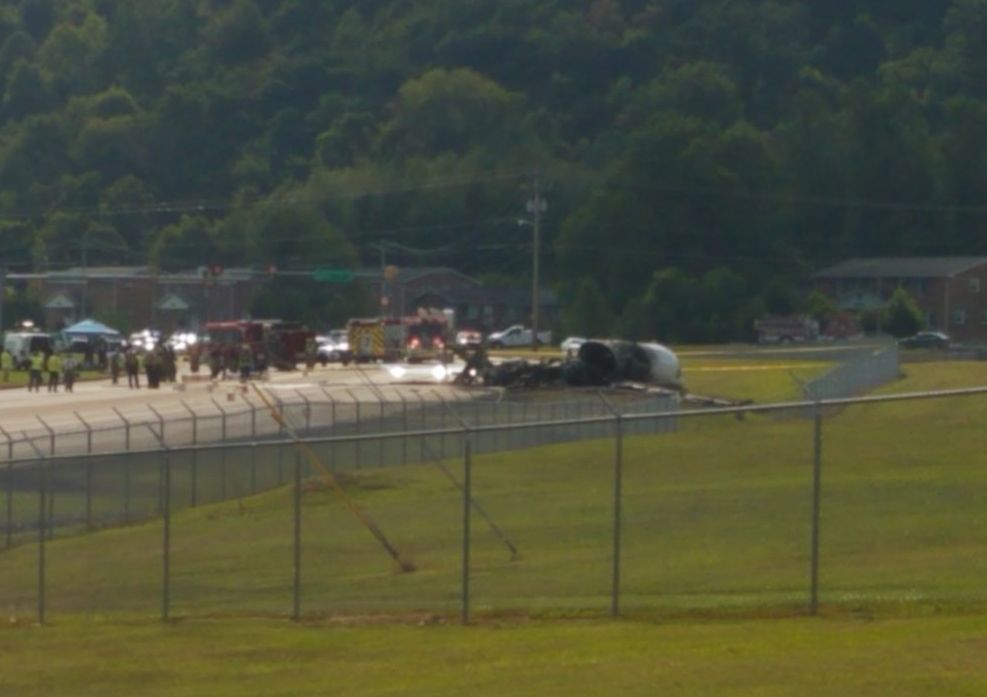In a final accident report published on Wednesday, the National Transportation Safety Board (NTSB) found decisions made by the pilot and copilot to be the probable cause of the 2019 crash of a Cessna Citation 680 business jet carrying former NASCAR driver Dale Earnhardt Jr., his wife, Amy, and their 1-year-old daughter, Isla. According to the Board’s report (PDF), the aircraft came in too fast and bounced on landing, touching down a total of four times before the right main landing gear collapsed. Following the gear collapse, the plane slid off the runway, going through a ditch and a fence before coming to rest approximately 600 feet from the runway threshold.
The NTSB found that aircraft initially touched down at around 18 knots above Vref. Counter to the landing checklist, the pilot did not extend the aircraft’s speedbrakes on touchdown, instead electing to deploy thrust reversers. A go-around was attempted on the third bounce, but “electronic engine controls prevented the increase in engine power because the thrust reversers were not stowed.” The Board determined that the accident was the result of “the pilot’s continuation of an unstabilized approach despite recognizing associated cues and the flight crew’s decision not to initiate a go-around before touchdown …” Contributing factors included “the pilot’s failure to deploy the speedbrakes during the initial touchdown … and the pilot’s attempt to go around after deployment of the thrust reversers.”
As previously reported by AVweb, the accident occurred on Aug. 15, 2019, at approximately 3:40 p.m. local time at Tennessee’s Elizabethton Municipal Airport (0A9). Minor injuries were sustained by the three passengers onboard. The aircraft was destroyed in a post-crash fire.



































Jeez, ya’d think that a type rated commercial pilot, possibly with an ATP rating, would know the landing routine. Scary.
Why would you think that? The accident record every year contains similar examples of rated pilots committing such blunders. Having a type rating guarantees only that a pilot has…a type rating.
The wisdom in your reply is perfect and profound!
Indeed. And almost all do, every time. This is only news because not only did they fail to follow that routine, but it hints at a build up of slack thinking over time. This was clearly the one incident too many.
Any pilot can have an aproach not go as planned…for numerous reasons. The apparently simple solution of executing a go-around is too often ignored. Plan continuation bias, or ego, takes over.
The biggest safety item at my airline year after year is unstabilized approaches continued to a landing. “NOT ENOUGH GO AROUNDS!!”, they tell us. Its a trap commonly succumbed to among all of us across the ranks.
As much as Id love to believe moral purity and iron will exists in those commenting on here shaking there heads at this accident, I’m fairly certain a high percentage of us have tried to salvage one or two approaches and/or landings when we shouldn’t have.
Its a bummer this pilot only tried to go around after three bounces, then was outsmarted by the computer, but I can see how it could happen to alot of people. Of course, never me though. /s
“Outsmarted by the computer”. Well, sort of. I’m not rated in this aircraft, but I think you’re supposed to deploy the speed brakes to slow down (in the flare?) and you don’t deploy thrust reversers until you have stopped flying. Part of the reason for that: the engines can’t simultaneously thrust in two directions. So you don’t use reverse thrust until you are certain that you won’t need to go around, because a go-around becomes unavailable once they are deployed.
So this cowboy’s decision to make up his own checklist made a go-around impossible, I think. That’s not the computer; I think the same thing would have happened on a jet from the 60s or 70s, without any sort of computer.
Why any pilot would unnecessarily remove their option to go around is a mystery to me. Going around is an arrow you always want to have in your quiver.
Had to chuckle when reading : NTSB says “Pilot Error” well DUHHHH
18K above Vref? That ain’t no Cessna 172…Yikes!
If a go around is necessary, the decision has to made before extending speed brakes or thrust reversers. Once they are deployed you are committed to the landing. No go around after TR deployment is actually a limitation in some jets. It takes too long to stow them after deployment. This is an issue the FAA and NTSB discussed in a SAFO that was put out not long ago. This airport has terrain, trees, and other obstacles to consider. It just sounds this approach was a @#$&% from the start.
All the racket pilots have to deal with flying these newer jets is distracting and–in some cases–unnecessary and disregarded. The systems are designed for certain functions that turn around to bite the crew if they’re unfamiliar with those functions. Just when you need a jet to respond to your actions, it automatically deprives the pilot of that ability. There was a fairly similar accident with an Airbus where the pilot flew a low-and-slow flyby of a small airport, then cobbed the power to initiate a climb. The stick wouldn’t respond to his pitch command, and the plane collided with trees and crashed. I am studying the effects of automation on pilots. Though some pilots have told me this is flogging a dead horse, a few recent fatal events have revived that horse, and it’s important that pilots and aircraft designers should revisit the corral.
Hi David B, I believe the Airbus you referred to was a company test flight in Toluse France where the THRUST levers did not respond. Not stick..
My recollection.